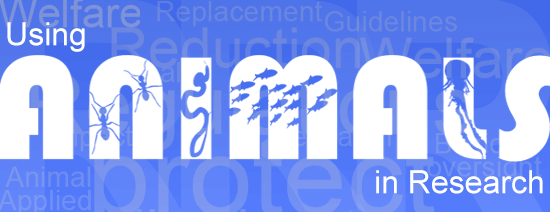Regulations for Animal Well-being
In response to increased public concern for the treatment and well-being of animals used in research, many new regulations and laws were passed to help protect animals. For example, the Animal Welfare Act in 1966 outlined the minimum standards for the treatment of animals both during and after any research study.

After the passing of the Animal Welfare Act by the United States, the United Kingdom passed a very similar law, called the Animal Scientific Procedures Act (ASPA). This new law was passed in 1986.
Compared to the guidelines put in to place by the United States, ASPA provided stricter guidelines on how to treat animals. Central to ASPA was the concept of the three R's:
Replacement
- When possible, scientists should avoid using vertebrate animals, like lizards, fish, or rabbits and use animals that have a less complex nervous system. These animals might include insects, nematodes, or bacteria. This means that scientists should only use vertebrates if it is absolutely necessary for a specific research study.
- When possible, research techniques that do not require animals should be used, like tissue culture or computer simulation. This is to limit the number of animals involved in research.
Refinement
- Animal well-being should always be kept in mind throughout the research process. This means minimizing any pain or stress for the animal. Animal stress or pain is only allowed if it is absolutely necessary for the outcome of an experiment.
- Animal welfare includes providing animals with high quality food, a clean living space, and access to an interactive social environment. These requirements promote proper care for the animals during the study.
- Importantly, these guidelines also tend to provide better scientific results for the researchers. This is because the test animals are in environments with fewer confounding variables like stress, disease, or isolation.
Reduction
- Scientists should try to use the smallest number of animal subjects in a given study. By doing so, researchers reduce the need for animal research subjects. It also requires scientists to think more about how to do this, when also may improve the quality of the scientific findings.
The three R's have become central to the current ways of understanding and preserving the ethical treatment of animals in research. You can find more information on these guidelines here.
Additional images via Wikimedia Commons. Image of C. Elegans worm by Heiti Paves.
Read more about: Using Animals in Research
Bibliographic details:
- Article: The Three R’s for Animal Treatment and Well-being
- Author(s): Dr. Biology
- Publisher: Arizona State University School of Life Sciences Ask A Biologist
- Site name: ASU - Ask A Biologist
- Date published:
- Date accessed:
- Link: https://askabiologist.asu.edu/animal-research-regulations
APA Style
Dr. Biology. (). The Three R’s for Animal Treatment and Well-being. ASU - Ask A Biologist. Retrieved from https://askabiologist.asu.edu/animal-research-regulations
Chicago Manual of Style
Dr. Biology. "The Three R’s for Animal Treatment and Well-being". ASU - Ask A Biologist. . https://askabiologist.asu.edu/animal-research-regulations
Dr. Biology. "The Three R’s for Animal Treatment and Well-being". ASU - Ask A Biologist. . ASU - Ask A Biologist, Web. https://askabiologist.asu.edu/animal-research-regulations
MLA 2017 Style

According to the rule of replacement, scientists should avoid using vertebrate animals, like fish or lizards. Instead, they should use invertebrate animals, like the C. elegans worm shown here.
Be Part of
Ask A Biologist
By volunteering, or simply sending us feedback on the site. Scientists, teachers, writers, illustrators, and translators are all important to the program. If you are interested in helping with the website we have a Volunteers page to get the process started.

